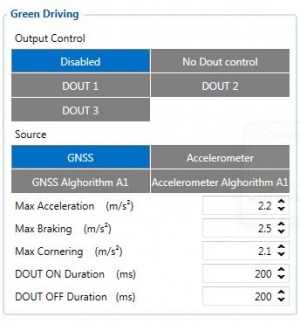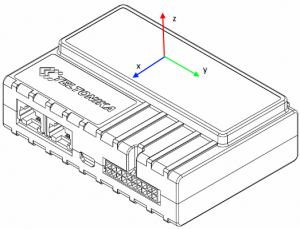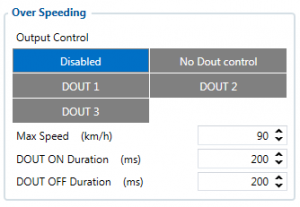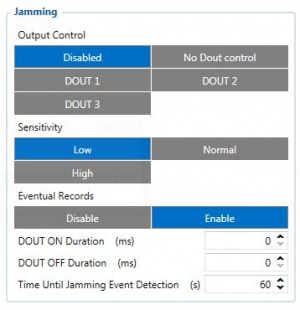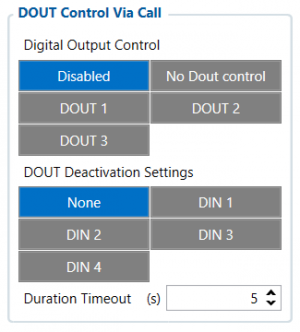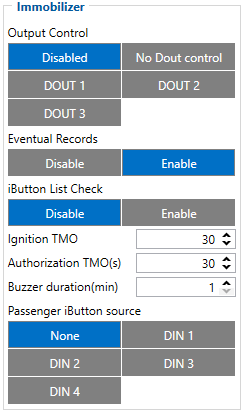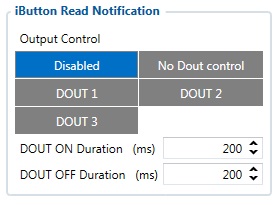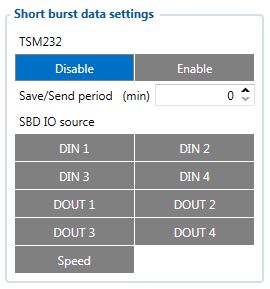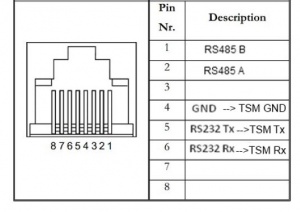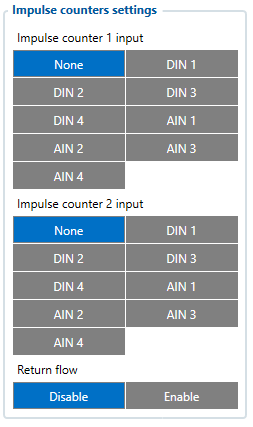Difference between revisions of "Template:FMB640 Features settings"
| (9 intermediate revisions by 2 users not shown) | |||
| Line 37: | Line 37: | ||
</tr> | </tr> | ||
</table> | </table> | ||
| − | {{{pic_accelerometerposition|[[Image:FMB640accelerometerposition.png|300px|right]]}}} | + | {{{pic_accelerometerposition|[[Image:FMB640accelerometerposition.png|300px|right]]}}} [[FMB640]] Device accelerometer position. (With positive Z axis pointing to Ground and antennas face forward in the vehicle). Before operation with the vehicle on level ground user must send “setacc” SMS. |
===Auto calibration=== | ===Auto calibration=== | ||
| Line 102: | Line 102: | ||
==iButton Read Notification== | ==iButton Read Notification== | ||
| − | [[Image: | + | {{{pic_ibutton|[[Image:I button.JPG|300px|right]]}}} |
| − | |||
| − | |||
| − | |||
| − | *If | + | * If the scenario is enabled, when iButton is attached and is successfully read, configured DOUT goes ON for configurable amount of time (min: 0.00 s; max: 5.00 s; default: 0.2 s). <br> |
| − | *If | + | * If DOUT ON and DOUT OFF durations are both set to 0, DOUT will be ON until iButton will be removed from the reader. <br> |
| − | *If | + | * If the Immobilizer scenario is enabled and iButton’s indication scenario is enabled and the same DOUT controls are chosen then in case iButton is attached DOUT is not affected. |
| − | + | IButton’s event generation works as a standard IO event generation | |
| − | |||
| − | |||
| − | |||
| − | |||
| − | |||
| − | |||
| − | |||
<br/><br/> | <br/><br/> | ||
| − | + | '''Confirmation about successful iButton identification with configured DOUT ON indication''' | |
| + | If DOUTX iButton read notification parameter is configured to control DOUTX and DOUTX is ON, then when new iButton is successfully read, DOUTX is turned OFF for 0,5 seconds and then turned back ON. By “new iButton” it is meant that the value read by (let’s say Driver’s) iButton reader is either different compared to what was read before or it’s the first time this iButton is read. | ||
| + | <br/><br/><br/> | ||
==Short burst data settings== | ==Short burst data settings== | ||
| + | {{{short_burst|[[Image:Short_burst.JPG|300px|right]]}}} | ||
| − | + | [[FMB640]] supports Iridium devices which can send short burst data (SBD) to the server. This means that some data can be sent from FM device to the server through satellites. | |
| − | |||
| − | |||
| − | |||
| − | |||
| − | [[ | + | [[FMB640]] will enable satellite mode only if a device can not send data via GPRS. Satellite mode has his own Save/Send period. If timeout is set to 0 no periodic records will be made. It is not recommended to save records often because of satellite traffic prices. 8 kilobytes monthly data limit is hardcoded in firmware. If the data limit is reached – the data limit counter will reset automatically only on next month first day or you can rest counter by SMS command ''“sbdlimitsreset”''. |
| − | |||
| − | |||
| − | |||
| − | |||
| + | In addition, you can select which IO element can generate Satellite records. In order to do that you need to go to I/O tab select IO record priority Panic and check the checkbox “Satellite I/O” what you want to get that data through satellites if there is no GSM connection. | ||
| + | Record which will be sent through the Iridium satellite network will be different than the regular record. It will contain 4 bytes timestamp, 3 bytes longitude, 3 bytes latitude, 1 byte record generation info, 1 byte DIN, DOUT info, 1 byte speed value. | ||
| − | + | {{{pic_connection|[[Image:connection.JPG|300px|center]]}}} | |
| − | ''''' | + | '''NOTE''': Port1/2 cable from FM package can be used for [[TSM232]] connection. For this you need to cut a D-SUB connector and connect wires according to the instruction above (PIN 4 to TSM GND, PIN5 to TSM Rx, PIN6 to TSM Tx). |
| − | + | {{{pic_connector|[[Image:connector.JPG|600px|center]]}}} | |
| − | |||
| − | |||
| − | |||
| − | |||
| − | |||
| − | |||
| − | |||
| − | |||
| − | |||
| − | |||
| − | |||
| − | {| | ||
| − | |||
| − | |||
| − | |||
| − | |||
| − | |||
| − | | | ||
| − | |||
| − | |||
| − | |||
| − | |||
| − | |||
| − | |||
| − | |||
| − | |||
| − | |||
| − | |||
| − | |||
| − | |||
| − | |||
| − | |||
| − | |||
| − | |||
| − | |||
| − | |||
| − | |||
| − | |||
| − | |||
| − | |||
| − | |||
| − | |||
| − | |||
| − | |||
| − | |||
| − | |||
| − | |||
| − | |||
| − | |||
| − | |||
| − | |||
| − | |||
| − | |||
| − | |||
| − | |||
| − | |||
| − | |||
| − | |||
| − | |||
| − | |||
| − | |||
| − | |||
| − | |||
| − | |||
| − | |||
| − | |||
| − | |||
| − | + | '''NOTE''': SBD data is limited to 8000 Bytes per month. For firmware with a bigger SBD data limit, please ask your sales manager. | |
| − | ''' | + | If the data limit is reached you can reset it with SMS command ''“sbdlimitsreset”''. |
| − | |||
| − | |||
| − | |||
| − | |||
| − | |||
| − | |||
| − | |||
| − | |||
| − | |||
| − | |||
| − | |||
| − | |||
==Impulse Counters Settings== | ==Impulse Counters Settings== | ||
Revision as of 12:07, 8 September 2021
Green Driving
When vehicle parameters exceed the values of Max Acceleration, Max Braking or Max Cornering parameters, the scenario is activated: a record is generated and digital output status is changed to 1 when configured. You can configure all three parameters in m/s2 units. Scenario is activated until current Acceleration, Braking or Cornering value decreases below the set parameter value.
Parameters used with Green Driving functionality are given in a table below.
| Parameter name | Description |
|---|---|
| Output Control | Enable/Disable Green driving functionality and Activate/Deactivate DOUT. |
| Max Acceleration | Value which can be reached while accelerating without triggering harsh acceleration event. |
| Max Braking Acceleration | Value which can be reached while braking without triggering harsh braking event. |
| Max Cornering Acceleration | Value which can be reached while cornering without triggering harsh cornering event. |
| Source | Which source data will be collected from:
Note: To use “Accelerometer Algorithm A1” option user need to install device as in Figure 1. |
FMB640 Device accelerometer position. (With positive Z axis pointing to Ground and antennas face forward in the vehicle). Before operation with the vehicle on level ground user must send “setacc” SMS.
Auto calibration
The auto-calibration process is the following:
- The vehicle is stopped.
- There is a straight road ahead.
- Send SMS "auto_calibrate:set" to the FMB device.
- Accelerate to >30 km/h for 5 sec.
- FMB will send a response when calibration is completed successfully.
Calibration is saved to internal flash memory, which means it will stay after a reset. To check auto-calibration status send a following short text message to the FMB device: "auto_calibrate:get".
Over Speeding
When vehicle speed exceeds configured maximum speed value the scenario is activated, an event record is generated and digital output status is changed to 1 when configured.
Scenario is active until detected speed decreases below the set parameter value.
info
DOUT1, DOUT2 or DOUT3 can be activated for a period of time to warn the driver. Output on-time is configured separately for each feature case. For more information please refer to DOUT controls.
Jamming
When jamming is detected the scenario is activated, an event record is generated and digital output status is changed to 1 when configured once Jamming timeout runs out. If jamming ends during timeout countdown no event will be generated and output will not be controlled.
Eventual Records parameter can be configured: when it is disabled scenario status value will appear in each AVL record, otherwise it will be appended only to eventual records.
DOUT Control via Call
Activates DOUT on incoming call.
The scenario is activated and digital output is ON when a call is received from a number which is in authorized numbers list.
Call control functionality:
- When FMB64 is configured to control DOUT1/DOUT2/DOUT3/DOUT4 device waits for an incoming call from the configured secure number. If the call is received FMB64 turns on DOUT1/DOUT2/ DOUT3/DOUT4 for user-defined Duration timeout (s). If the Duration timeout set to „0“(s), DOUT1/DOUT2/ DOUT3/DOUT4 will be OFF.
- DOUT1/ DOUT2/DOUT3/DOUT4 can be turned off by Duration timeout (s) or by digital input 1, digital input 2, digital input 3, or digital input 4 (DOUT deactivation settings).
- DOUT1/DOUT2/DOUT3/DOUT4 can be turned off before Duration timeout (s) by selected DIN (DOUT deactivation settings).
- DOUT1/DOUT2/DOUT3/DOUT4 always will be ON, if DOUT deactivation set to DIN1 for example, but DIN1 will be never turned ON or set Duration timeout to Max value (2147483647) it is about 68 years.
Authorized driving/Immobilizer
- If DOUT Control is disabled, the scenario will only generate events without digital output activation. If DOUT Control is enabled DOUT1/DOUT2 turns ON if ignition turns ON (Ignition Source is configured to 1).
- After any iButton ID is attached, DOUT1/DOUT2/DOUT3 turns OFF.
- After iButton identification configured Ignition Source can be turned OFF (Ignition Source is configured to 0) for no longer than 30 seconds, otherwise immobilizer must be repeated.
- If iButton List Check parameter is enabled, the authorization will be successful only if the attached iButton is specified in the iButton list.
- Ignition off timeout parameter is used to set the duration after which authorization is activated when the ignition is turned off.
- Authorization off timeout parameter is used to set the duration of how long the user has time to authorize after switching the ignition ON.
- iButton list gives the ability to use the vehicle for 1000 specific iButton owners (specified in iButton list). Selected DOUT is controlled by scenario for user needs, to manage buzzer, LED, etc.
iButton Read Notification
- If the scenario is enabled, when iButton is attached and is successfully read, configured DOUT goes ON for configurable amount of time (min: 0.00 s; max: 5.00 s; default: 0.2 s).
- If DOUT ON and DOUT OFF durations are both set to 0, DOUT will be ON until iButton will be removed from the reader.
- If the Immobilizer scenario is enabled and iButton’s indication scenario is enabled and the same DOUT controls are chosen then in case iButton is attached DOUT is not affected.
IButton’s event generation works as a standard IO event generation
Confirmation about successful iButton identification with configured DOUT ON indication
If DOUTX iButton read notification parameter is configured to control DOUTX and DOUTX is ON, then when new iButton is successfully read, DOUTX is turned OFF for 0,5 seconds and then turned back ON. By “new iButton” it is meant that the value read by (let’s say Driver’s) iButton reader is either different compared to what was read before or it’s the first time this iButton is read.
Short burst data settings
FMB640 supports Iridium devices which can send short burst data (SBD) to the server. This means that some data can be sent from FM device to the server through satellites.
FMB640 will enable satellite mode only if a device can not send data via GPRS. Satellite mode has his own Save/Send period. If timeout is set to 0 no periodic records will be made. It is not recommended to save records often because of satellite traffic prices. 8 kilobytes monthly data limit is hardcoded in firmware. If the data limit is reached – the data limit counter will reset automatically only on next month first day or you can rest counter by SMS command “sbdlimitsreset”.
In addition, you can select which IO element can generate Satellite records. In order to do that you need to go to I/O tab select IO record priority Panic and check the checkbox “Satellite I/O” what you want to get that data through satellites if there is no GSM connection. Record which will be sent through the Iridium satellite network will be different than the regular record. It will contain 4 bytes timestamp, 3 bytes longitude, 3 bytes latitude, 1 byte record generation info, 1 byte DIN, DOUT info, 1 byte speed value.
NOTE: Port1/2 cable from FM package can be used for TSM232 connection. For this you need to cut a D-SUB connector and connect wires according to the instruction above (PIN 4 to TSM GND, PIN5 to TSM Rx, PIN6 to TSM Tx).
NOTE: SBD data is limited to 8000 Bytes per month. For firmware with a bigger SBD data limit, please ask your sales manager. If the data limit is reached you can reset it with SMS command “sbdlimitsreset”.
Impulse Counters Settings
Pulse counter functionality enables the FMX640 devices to count digital impulses going to Digital and Analog Inputs. This means that these inputs of the FMX640 devices can now be used for precise fuel flow meter data reading. Impulse based fuel usage monitoring is much more accurate than a different type of fuel metering sensors and it makes the FMX640 devices a perfect solution for high fuel usage machines like cranes, construction vehicles, mining machines, agriculture equipment.
How does it work?
When "Impulse Counter 1/2 input" is selected and "Fuel Counter/Impulse Counter 2" IO elements are enabled, device will count every input state change to HIGH and send the counted number with the next record. Pulse counter value is reset after sending the record.
NOTE: Impulse Counters feature is available from FW ver. 01.02.02
I/O elements - Each counter has a corresponding IO elements for "Impulse Frequency" - value in Hz and "Impulse RPM" - impulse count per minute.
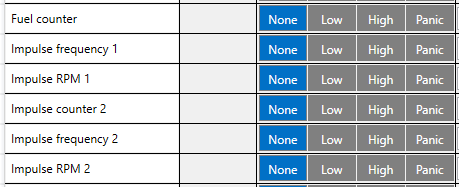
Additionally - some fuel meters have a return flow counter as well:
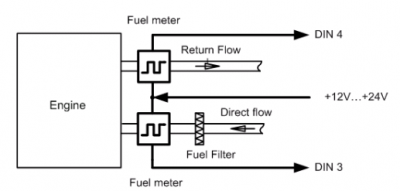
In this case - you can select which inputs are used for direct (Impulse counter 1) and return (Impulse counter 2) lines and enable "Return Flow" - when this parameter is enabled - "Fuel Counter" IO element will have a value of Direct Flow impulses substracted by Return Flow impulses.
For example:
- Direct Flow=50 impulses.
- Return Flow=10 impulses
- Fuel Counter=40 - if "Return Flow" is enabled.
Note that each Input has a specific requirements for signal frequency and threshold:
| Input | Max frequency (Hz) | Min Voltage threshold (V) |
|---|---|---|
| DIN1 | 50 | 7.5 |
| DIN2 | 30 000 | 2.5 |
| DIN3 | 30 000 | 2.5 |
| DIN4 | 30 000 | 2.5 |
| AIN1 | 10 000 | 2.5 |
| AIN2 | 10 000 | 2.5 |
| AIN3 | 10 000 | 2.5 |
| AIN4 | 10 000 | 2.5 |
